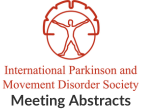Multiple Neural Networks dysfunction in Primary Blepharospasm: An Independent Components Analysis Study
Objective: This study aimed to explore altered functional brain connectivity and the possible correlations of these networks with clinical variables in BPS. Background: Primary blepharospasm (BPS) is a focal dystonia characterized by involuntary blinking and eyelid spasms. The pathophysiology of BPS remains unclear. Methods: Twenty-five patients with BPS and 25 age-and gender-matched healthy controls received resting-state fMRI scan. Group ICA was performed with the GIFT toolbox. Results: (1) There were no significant differences in the demographic variables between two groups besides the HAMA scores [table 1]. (2) Comparing with healthy control group, BPS patients exhibited different resting-state connections within sensory-motor network (SMN), right frontoparietal network (rFPN) and salience network (SN) [figure 1, figure 2]. BPS patients exhibited decreased connectivity within SMN that involved regions of the bilateral primary sensorimotor cortex, supplementary motor area, right superior frontal gyrus (BA 6), bilateral precuneus and left superior parietal cortex [table 2]. Within rFPN, decreased connections were observed in the middle frontal gyrus, DLPFC and inferior frontal gyrus [table 3]. Regarding salience network, increased connectivity was observed in the left superior frontal gyrus and middle frontal gyrus (including the DLPFC) [table 4]. We found positive correlation between the left superior frontal gyrus and HAMA scores, but this result was not significant. (3) Among the BPS patients, 12 performed sensory tricks positive (ST+), 9 perform sensory tricks negative (ST-). ST+ as compared to ST- patients exhibited significant higher connectivity in right premotor cortex within SMN [figure 3, table 5]. The results also showed a significant negative correlation between the right superior frontal gyrus and disease duration (Pearson's correlation r = -0.414, p = 0.038)[figure 4]. (4) We compared the SMN connectivity maps from pre- and after- treatment of 6 patients, but found no significant result. Conclusions: Multiple neural networks dysfunction may play roles in BPS.Altered Resting-State Functional Interhemispheric Connectivity in Parkinson’s Disease
Objective: To examine direct interhemispheric functional connectivity (FCi) in Parkinson's disease (PD) during resting-state fMRI and to investigate the relations between observed connectivity changes and…Disrupted superior collicular activity may reveal cervical dystonia disease pathomechanisms
Objective: To assess by functional magnetic resonance imaging, the response of the superior colliculi to a looming stimulus in cervical dystonia patients and their unaffected…Dopamine Normalizes Putamen to Insula Activation Shift During Choice Reaction Time Task in PD
Objective: We investigated Parkinson’s disease (PD) patients during a functional MRI Choice Reaction Time (CRT) task and determined whether brain activations are altered by dopamine. Background:…Associations between Functional Networks and Temporal Discrimination Thresholds in Cervical Dystonia patients and their unaffected relatives
Objective: To investigate resting state functional networks across cervical dystonia patients and their unaffected relatives with and without abnormal temporal discrimination thresholds (TDTs) based on…Alterations in Dynamic Brain Connectivity Patterns in Parkinson’s Disease
Objective: To explore the time varying brain connectivity networks in Parkinson's disease (PD) during resting-state fMRI and to investigate the correlate between connectivity dynamics and…Impaired sensorimotor and visual networks in drug naive Parkinson’s disease based on graph theoretical analysis
Objective: We aim to investigate topographic structure in drug naive patients with Parkinson’s disease (PD). Background: Resting state functional magnetic resonance imaging (rs-fMRI) provides valuable…Assessing Nigral Functional Connectivity in Parkinson’s Disease with Resting State Functional MRI
Objective: To evaluate functional connectivity of SN with basal ganglia and motor cortex in Parkinson’s disease (PD) using resting state functional MRI (RS fMRI). Background:…Anxiety influences the neural correlates associated with freezing of gait in Parkinson’s disease
Objective: To evaluate whether Anxious Freezers have altered brain activity during FOG episodes compared to Non-Anxious Freezers. Background: A growing amount of research has emphasized…Modulation of executive motor network after neurofeedback training in Parkinson’s disease
Objective: To identify changes in effective (i.e. directed) connectivity in the executive motor network during finger tapping. To compare the effects of two rehabilitation strategies. …
- « Previous Page
- 1
- …
- 25
- 26
- 27
- 28
- 29
- …
- 31
- Next Page »
